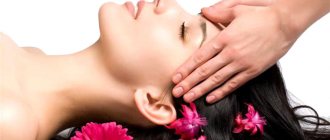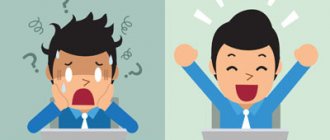The relaxation effect spreads and is consolidated. Unsystematic and superficial relaxation exercises give a temporary, incomplete effect. Only regular practice in accordance with the methodology leads to sustainable generalization and long-term positive relaxation effects. There is a division into long-term relaxation, which occurs during sleep, hypnosis, under the influence of pharmacological influence, and relatively short-term... If the weather permits, it is better to go out of town for a vacation. At least a few kilometers of walking in nature, breathing fresh air, pleasant fatigue: a little physical activity is one of the stages of preparation for quality rest. Try not to think about current affairs, problems - better yet, nothing at all, listen to the silence and feel how you become part of this silence.
Any relaxation at home is useful if only the following goal is achieved: the body is relaxed, completely rested, the mind is clear and bright, no thoughts hang over the territory of our brain. Everyone knows how to relax, and many believe that they know how to do it well - some with a glass of “tea”, others with “TV”, others in nature. But why do some people have a headache after such a vacation, while others don’t want to go to work? And every time, many hundreds of “working people” confirm the proverb that Monday is a hard day after a fruitful rest on the weekend. All this happens because each of us has our own understanding of what relaxation is, often interpreting it as lying on the couch listening to soothing music.
How to distinguish relaxation from rest?
Relaxation techniques are quite popular in yoga, psychotherapy, hypnosis and various health systems. Relaxation techniques, similar to meditation, are believed to be effective ways to combat stress. The purpose of relaxing muscles and relieving psycho-emotional tension is to get rid of stress and restore strength. It is no coincidence that relaxation is considered one of the most effective ways to improve performance: with the right approach, high physical and mental activity is ensured. For hypertension, physical exercise is also recommended. Special techniques allow muscles to relax, thereby minimizing the risk of destructive processes in muscle tissue and psychosomatic disorders.
Relaxation for quality sleep
1. The most general meaning is a state of low tension in which the emotional level, especially the level of emotions such as anxiety, fear, anger, etc., decreases. 2. the process used to cause the condition; see here relaxation therapy. 3. more details…. There are various relaxation techniques that can help combat stress and maintain well-being in conditions of increased stress and constant emotional tension. By choosing the right methods, any person can independently restore their strength, increase their performance and normalize their psycho-emotional state. Regularity is considered the key to effective relaxation, so physical exercise should become an integral part of everyday life.
Summarize
The most common cause of muscle tension is stress. This is understandable: today’s rhythm of life presents us with various surprises, which we cannot always avoid. As soon as you allow negative thoughts or fear, the body immediately turns on the readiness mode to fight the enemy, tensing its muscles. It’s not for nothing that they say that all diseases are caused by nerves, because in this way we do not allow the body to function properly and disrupt its natural processes.
In fact, everything is simple: to eliminate pain and spasms in muscles and relax, you need to identify the source of anxiety and learn to control your emotions. Just for this, we have an online program “Mental Self-Regulation”, where you will learn to cope with stress, difficult relationships, anxiety and fear and other “inhibiting” factors.
Avoid physical overload, don’t get nervous over trifles and remember that your health is a treasure and needs to be protected!
Good luck!
We also recommend reading:
- Storytelling
- 10 Popular Exercises to Relieve Stress
- What to do with psychological problems?
- Is it possible to do without a psychotherapist?
- How to learn to relax: effective relaxation techniques
- Methods of mental self-regulation
- The main ideas of Konstantin Stanislavsky
- Systematic desensitization of Joseph Wolpe
- Isometric exercises
- How to run correctly
- Methods of mental self-regulation: save yourself
Key words:1Psychoregulation
Why relaxation?
Mental relaxation technique is a part of the meditation process that allows you to relax by creating various mental images. A simple technique that is often used on a subconscious level is breathing. Its importance lies in performing breathing exercises that help overcome anxiety and develop the correct type of breathing. The technique of performing the exercises may vary depending on the chosen direction of relaxation breathing. The second is the restoration of strength and tone of the body. Why not combine these two definitions into one: relaxation does not always mean passively spending time and rest as such, while for relaxation this is a prerequisite.
Introduction
“People who know how to relax not only have greater mental flexibility, but are also better able to deal with stress.”
R. Copelan
Hello, dear friend! You've probably heard about such a phenomenon as relaxation. Many people underestimate and underestimate this very effective technique for gaining health. But in vain! I pay a lot of attention to HER, because... Relaxation is the basis for your own development, be it the development of personal qualities, the cure of serious illnesses, or the development of intuition.
For me personally, relaxation is a very important tool in the life of a modern person, which is filled with physical and mental tension, as well as such a common phenomenon as stress.
You may be surprised, but I mastered many relaxation techniques at an early age, and the word “meditation” became a staple in my vocabulary. And for this I am grateful to my parents, who gave me a good upbringing, based on which I followed the path of self-development and improvement.
Thank you Mom and Dad, you are my best teachers and friends!
Which relaxation is better for the body?
What is relaxation? Previously, there was an equal sign between the terms “relaxation” and “rest,” but now they are clearly distinguished. The first includes measures aimed at calming the human psyche and restoring mental balance. Using relaxation, you restore inner harmony and peace, and also help your body recover. It is very important to practice relaxation, this way you will give your body the opportunity to rest, put aside a new resource that will provide it with energy. Consciously observing your body will help you improve your physical condition. Author: Inna Rykberg
Relax
Even passive relaxation on the sofa is not always good relaxation if the refrigerator is rattling and the TV is humming in the next room. To find peace of mind, reduce exposure to irritants to a minimum and spend half an hour or an hour in this state. An improved version of the “home massager” is the Yamaguchi massage chair. The device is intended for people who need deep relaxation of the muscles of the back, neck and buttocks. By kneading and warming tissues, the electronic assistant helps relieve fatigue, both physical and mental, and get rid of back pain. And although its acquisition is associated with significant costs, it is a one-time expense. Unlike the services of a professional massage therapist, who must pay for each session.
Relaxing with breathing
One of the reasons for muscle tone is stress. The abdominal muscles respond first to stimuli. These muscles, when tense, put pressure on the diaphragm during inhalation, which leads to a lack of oxygen in the body: it simply lingers in the upper part of the lungs and does not pass further. In this state, a person feels as if he can’t breathe, begins to get nervous, panics, and his breathing quickens, which only worsens the situation.
The abdominal breathing technique allows you to relax the abdominal muscles and restore the breathing process. It helps to avoid insomnia, depression and atherosclerosis and even get rid of some types of pain. A person can restore his condition in just three inhalations and three exhalations.
To do this, just do the following exercises:
- Lie on your back, close your eyes and concentrate on your bodily sensations. Take a few breaths in and out and watch the reaction of your chest and abdomen.
- Perform a cycle of slow inhalations and exhalations, go to your breathing pace, gradually getting rid of muscle tension.
- With one hand, press lightly on your stomach and try to make your stomach lift and lower your hand. This way you will learn to regulate the air flow.
- Inhale and, counting to ten, count the number of exhalations. Repeat the exercise for ten minutes.
Belly breathing has a positive effect on the nervous system, helps relieve tension during stress, lowers blood sugar levels and improves the body's condition after exercise.
Digestion also improves, the lungs are strengthened, and during breathing exercises the heart and internal organs are massaged. But this method of relaxation is not suitable for those who have high blood pressure, and it is best to start studying breathing practice under the supervision of specialized specialists [E. Mukhina, 2019].
So why is vertical (chest) breathing considered wrong? When we breathe with our chest, as we inhale, our chest and shoulders rise, which triggers the sympathetic part of the nervous system in the body. With proper breathing, the shoulders and chest remain motionless, only the stomach is involved.
Proper relaxation and tension of the intercostal muscles and working with the diaphragm will help you take full breaths and exhales. Try to exhale so that your stomach “sticks” to your back. Feel like you've squeezed all the air out of your lungs?
To reduce stress and relax your muscles, the 4-7-8 method is great: sit up straight, touch the back of your upper teeth with the tip of your tongue, and stay in that position throughout the exercise.
Now start counting: on the count of 4, inhale calmly and quietly through your nose. On the count of 7, hold your breath and exhale until the count of 8, making some sound. The exhalation should be longer than the inhalation.
You need to take 4 full breaths at a time. You can perform this exercise whenever you want, but it is not recommended to exceed the number of breaths in the first month of practice.
Another muscle relaxation exercise, the 365 method, can be done throughout the day or in between different activities. It's very simple: breathe at a rhythm of six cycles per minute (5 seconds inhale, 5 seconds exhale) for five minutes. Do this every day for a year (hence, by the way, the name “365 method”) [Rospotrebnadzor, 2020].
A useful technique for healthy breathing was developed by Alexandra Strelnikova, an opera singer and teacher. Initially, this technique was aimed at restoring the voice and getting rid of attacks of suffocation (the singer herself suffered from them), but it also has a beneficial effect on muscle tone.
When performing breathing exercises by A. Strelnikova, the neck, abs, legs, arms, shoulders, back and pelvis are involved. Exercises have a beneficial effect on the immune system, cleanse the bronchi, improve posture and are recommended as therapy for pathologies of the chest muscles.
Breathing exercises should be performed before meals or 1-1.5 hours after a meal. It is contraindicated for those who have high blood pressure, head trauma, internal bleeding, high temperature, or weakness.
And here are the exercises themselves:
“Palms”: this is a warm-up before starting a workout. Stand up straight and open your palms as if you are showing them to someone. Lower your elbows and keep your arms away from your body. Inhale noisily through your nose and at the same time clench your palms tightly into fists. As you exhale, open your palms and relax. Repeat the exercise 4 times and rest for 3 seconds. You need to do 24 repetitions.
“Nose”: stand straight, place your feet shoulder-width apart, keep your arms along your body. Bend forward, but do not touch the floor with your hands, while inhaling loudly and briefly through your nose during the second stage of the tilt, ending at the bottom point. Get up and repeat the exercise 8 times. The bends should be light and rhythmic; you do not need to bend as low as possible. Round your back and lower your head.
“Cat”: take a half-squat position and simultaneously turn your body and arms to the right, as if you are trying to catch something, and then to the left. Exhale naturally, your knees should be half bent, and make the turns at the waist. The exercise can be performed while lying in bed or sitting on a chair.
Shoulder Hug: Stand straight and bend your elbows, raising them to shoulder height. Hug yourself by the shoulders, spreading your arms in opposite directions. With each hug, inhale and exhale sharply through your nose. It is not recommended to perform this exercise in the first week of training; it is also contraindicated for those who have heart problems.
“Big Pendulum”: stand straight, place your feet at a distance slightly narrower than your shoulders. Bend forward as if you were trying to reach the floor with your hands and inhale. Without interrupting the exercise, straighten your body, lean back, hugging your shoulders with your arms. Inhale from the floor and exhale from the ceiling. Do not pause in breathing and do not increase the pace [I. Rudevich, 2020].
We recommend watching a video where the main cycle of breathing exercises by Alexandra Strelnikova is conducted by her student, Dr. Mikhail Shchetinin:
What is relaxation? –
What this means can be read below. But before we continue, I would like to recommend you a few more popular articles on random topics. For example, what is fanzine, what is scrotum, what is agitation, how to understand the term baksheesh, etc. Then I abandoned the salon: my son went to first grade, there was no time. And about six months later, when there was a serious conflict in the family, I discovered that in the morning I felt broken again. But I already knew where to go to correct the situation. Gradually everything fell into place, and I established the rule once and for all: on Wednesday I go to the capsule. And if there is a tense situation in the family or at work, I always go unscheduled, even three times a week. Before answering the questions above, I would like to spend a little space on the topic of stress. Obviously, there is no smoke without fire. So, to use a proverb analogy, we relax to relieve stress. One hundred percent, you have already come across information about relaxation techniques, but for some reason it did not interest you, as you continue to read this article. Today there are many different techniques, methods and ways to learn how to enter this state.
Gymnastics in the office
At work, many of us spend most of our time sitting at the computer. This has a detrimental effect on the muscles of the back and shoulder girdle, and can also impair blood circulation in the legs. Someone, on the contrary, spends their working day standing and thus overloads the muscles of the back and lower extremities.
This mode of operation is fraught with serious consequences, but they can be avoided if you regularly do certain exercises :
- Relaxation of the neck muscles : slowly tilt your head first to the right and then to the left shoulder. Repeat the side bends 10 times, then do another 10 head tilts forward and backward. The exercise can be done while sitting at your desk or standing.
- Gymnastics for the eyes: often, due to prolonged work at the computer, you may feel the heaviness of the eyelids, dryness and pain in the eyes. To get rid of discomfort, just switch your attention to another object and sit with your eyes closed for several minutes. It is best to turn your eyes in different directions, move them left and right, up and down and diagonally.
- Relaxing the shoulder muscles: rotate your shoulders forward and backward 10 times in each direction.
- Relaxing the back muscles : stretch your arms up, bringing your palms together, and bend to the right and left sides. You should feel your back muscles working. Perform 10 bends in each direction. Then stretch your arms forward and stretch to the right side, lock in this position for a few seconds and then stretch to the left.
- Relaxing the arm muscles: rotate your wrists 10 times in each direction, shake your relaxed arms. Clench and unclench your fist, spreading your fingers as far apart as possible. Shake each finger and rotate it in different directions.
- Relaxing the leg muscles: Straighten your leg, stretching it forward, and then bend it. Repeat the exercise 20 times on each leg. Move your feet in different directions (at least 15 times). Stand on your tiptoes and lower both feet at the same time from toe to heel. To improve blood circulation, perform calf raises with both legs while standing.
If you perform these exercises regularly 2-3 times a day, you can achieve the desired result faster. The main thing is to do them smoothly and not be afraid of possible discomfort at first (this is possible due to stiff muscles) [T. Mantulina, 2020].
Candles
We hear many wise words from the media and the Internet, most of them require additional decoding. After all, not all citizens have a higher education, and those who have graduated from colleges and universities cannot put a few words together. All relaxation procedures are based on sensory stimulation (for example, massage, various types of gymnastics, spa capsule) or sensory deprivation, that is, deprivation of sensory stimuli (primarily floating in the air). If you correctly determine your type of perception, you will be able to choose the relaxation option that suits you. Just in case, you can try a little of everything: if you come out of the float tank feeling exhausted, look for a source of inner strength in a massage. The most important thing is to find your own relaxation and do it regularly.
What does relaxation mean?
Psychophysiological relaxation techniques refer to techniques for relaxing muscles using the mind and exercise. To use these techniques, comfortable conditions are important: absence of bright light, comfortable temperature, clothing that does not restrict movement, absence of annoying noises and other irritants. It is not recommended to practice relaxation on a full stomach, as digestion interferes with relaxation. The first method involves relaxation of muscle tissue, which follows the initial tension. The essence of this technique is that a person must tense the muscles (one or more groups) for 5-10 seconds, and then focus on relaxing them for 15-20 seconds.
Benefits of muscle relaxation for humans
Relaxation (from the Latin relaxatio “relaxation”) is a decrease in skeletal muscle tone, which is achieved with the help of special techniques, exercises, physiotherapy and medications.
Relaxation is especially important for those who have increased muscle tension or a tendency to sudden changes in muscle tone, which leads to various diseases.
Good tone is a balance between muscle tension, contraction and relaxation. If it is followed, then the human body remains strong and flexible, but in fact most people experience muscle tension. And this applies not only to those who are interested in sports, but also to those who are constantly in an unstable emotional state.
The causes of muscle tension are:
- Stressful situations: the muscles of the neck and shoulders, pelvic area and solar plexus area react to stress. Surely, before an exciting event, you felt as if a weight was hung on your shoulders or spasms appeared in the abdomen or chest, which made it even difficult to take a breath. It was so?
- Hypothermia: a person, when faced with cold, is forced to retain heat inside himself by tensing certain muscles. Therefore, those who live in cold regions often experience muscle spasms, tightness and pain.
- Sedentary lifestyle: we spend most of our lives in front of a computer at a desk or in a vertical position if work requires us to be on our feet. Can you imagine how stressful this is for our muscles? After all, probably not everyone watches their posture and periodically does a warm-up.
- Increased physical activity: have you noticed how after a long workout some muscles begin to ache? Such pain does not always indicate the benefit of the work done, or rather, its cause may just be the incorrect technique of performing physical exercises [A. Vladimirova, 2020].
When a muscle spasms, the capillaries are compressed and the outflow of blood is disrupted, i.e. oxygen and glucose begin to flow in insufficient quantities. As a result, metabolic products accumulate, swelling appears, which causes pain. And if the clamp is not removed, there is a risk of cell destruction. Muscle tension has a negative impact on sleep, performance and can cause apathy and irritability.
Muscle tension makes it difficult for nutrients to reach the internal organs, which causes a decrease in immunity and worsens the external condition. Can you imagine what will happen to your face in a couple of years if you constantly strain its muscles? Simply put, the ability to relax muscles maintains health, beauty and helps maintain emotional well-being. That is why it is important to monitor muscle tone and maintain its balance [V. Varygin, 2021].
To relax the muscles, it is not always enough to take a vertical position and get enough sleep, because the situation can be so advanced that even in sleep the body cannot enter a state of relaxation.
There are several techniques that help relax muscles:
- Osteopathy: a type of alternative medicine that implies that there is a certain connection between the functioning of organs and the musculoskeletal structure. Osteopaths relieve muscle tension by first determining the cause and source of tension.
- Massage: Another relaxation technique. It is less precise than osteopathy, but more pleasant.
- Thermal procedures: if cold causes muscle tension, then heat helps to relax them, so warm baths and saunas will come in handy if there are no contraindications [A. Vladimirova, 2020].
But there are several more effective relaxation techniques developed by scientists that you can put into practice yourself. Let's take a closer look at them.
Massage
Various relaxation techniques are especially effective for people with high muscle tension, as it is the cause of many diseases. People with low muscle tension are less likely to experience the effects of relaxation. When a person is exposed to stress, muscle tension occurs in the body. This tension is a defensive reaction that prepares the body for action. The body perceives a signal of a threat - stress, and activates active defense. (from Latin relaxatio - relief, relaxation) - a state of rest associated with complete or partial relaxation of muscles. There are two types of relaxation: long-term relaxation, which occurs during sleep, hypnosis and pharmacological treatment, and relatively short-term relaxation...
Relaxation massage: indications and contraindications
A relaxing back massage is worth it. Everyone needs a massage because it is recommended for:
Relaxation massage has contraindications
- Chronic fatigue.
- Increased muscle tension.
- Frequent colds.
- Depression.
- Insomnia.
- Emotional and physical fatigue.
- Nervous overstrain.
- Stressful situations.
However, like any therapeutic procedure, a relaxing full body massage has some contraindications. Please read these warnings:
- AIDS.
- Presence of malignant tumors.
- Thrombosis.
- Acute or chronic osteomyelitis.
- Angiitis, inflammation of the lymph nodes.
- Infectious, pustular, inflammatory formations on the skin.
- Predisposition to bleeding.
- Acute inflammatory or infectious process in the body.
Which relaxation is better for the body?
You will empathize with the characters or make an effort to do your favorite activity. This is not relaxation. It's just a break from hard work. Relaxation is doing nothing in the truest sense of the word. You are not there. There is only your body, which is calm to the extreme. Herbal teas affect many organs and systems. There's a reason some doctors prescribe them as their primary treatment. There are herbs that stimulate brain function. At the same time, they help you relax. This stimulation allows you to feel good and energetic for 24 hours. In addition, herbal teas promote calmness and temporarily banish heavy thoughts. And this is exactly what many modern people need. Leisurely drinking tea is a great way to relax. Anyone interested in psychology knows what it is.
What is relaxation
, that is, the spread and consolidation of the relaxation effect. Unsystematic and superficial relaxation exercises give only a temporary, incomplete effect. Only regular practice of this technique leads to stable generalization of the effect and long-term positive effect of relaxation. As a result, your heart rate slows down and your thoughts become clearer. Therefore, in this technique it is important to focus only on the breathing process. Consistent practice will teach you to relax anywhere and in any position.
Advantages of relocation for an employer
Personnel shortage is the main reason for the transfer of employees from one department to another. But relocation has other advantages that are successfully used by leading corporations.
A fresh look at new territories helps broaden the horizons and develop the creative potential of managers. Sending experienced employees to the regions leads to the growth of local corporate culture and the improvement of business processes in general.
Employees who agreed to move are focused on their tasks and work. The labor efficiency of these specialists increases, and the company receives greater returns from them than with routine work.
Another advantage of relocation is testing the potential of promising employees. Successful activities in a new place can become a launching pad for career growth.
What is relaxation - the meaning of the word in medicine and Wikipedia
Many people don't feel the need to relax in any other way than by changing activities. Thoughts like “I’ll go on vacation, then relax” are no better than the simple idea “let’s relax in “that world”! Yes, at some point we will all “rest in peace”! And I want to relax and work happily and joyfully, and give birth to and raise “a bunch” of grandchildren, “plant a house”, “build a tree”…. Here, too, the main condition is complete peace and quiet, so try to explain to your roommates why they should not be disturbed during their vacation. If you can go to a separate room and lock yourself there, great; if not, you can retire to the bathroom.
Music for meditation and relaxation
The lack of opportunities for quality recreation is the scourge of our time. Even if it seems to us that we are relaxing, it is usually not that kind of vacation: in modern cities there are too many sources of noise, too much stress, and, on the contrary, there are few reasons for joy and faith in the future. Now I can’t imagine life without regular sessions in a SPA capsule, although I didn’t try this type of relaxation right away. The first time I saw the capsule was after giving birth, when I started losing weight. I came to the salon for a body wrap, and they put me in a special device, turned on chromotherapy and ozone. I had a great half hour, but the volume was still there.
Why do we need relaxation?
– Breathing – deep and slow, correct breathing in nature, in the fresh air is the most important; – Privacy is an almost unattainable concept for most people, although you can try the bathroom; – Silence – if you live in a big city and silence is almost unattainable, you can turn on soothing, pleasant music; – Self-hypnosis is a must. You need to forget about your problems, worries, work. It is advisable not to think about anything at all during this time. In fact, this is the most basic part of relaxation, self-hypnosis, meditation. However, to achieve this, it will take years of training. Of course, real relaxation is an unattainable dream for a Western-minded person. You simply take the time to lie on the couch, couch, or grass and get some sleep before your day at work. – You must trust your body, and it will make its own choice. Even if you don’t manage to immediately get rid of muscle tension, it’s okay - after a few minutes the body itself will find the most comfortable position for itself. Continue not to think about anything, listen to the sounds of nature and your breathing.
Goals of the methodology
What is relaxation therapy? Everyone understands this term differently. When going to a spa or to a psychologist, each person pursues his own goals. Some people want to get rid of complexes and obsessions, while others want to relax with good music with the help of an experienced coach. Be that as it may, total relaxation solves a lot of problems:
- elimination of muscle tension;
- working on emotional trauma;
- personal growth;
- replenishment of the body's energy reserves;
- healing of the body.
Youth Dictionary – Relaxation
(Latin: relaxatio – relaxation of tension). A state of rest and relaxation of varying degrees of duration. It is caused in different ways: it occurs spontaneously during sleep, develops under the influence of certain psychotropic drugs, is one of the moments of psychotherapy... If the weather permits, it is better to go out of town for relaxation. At least a few kilometers of walking in nature, breathing fresh air, pleasant fatigue: a little physical activity is one of the stages of preparation for quality rest. Try not to think about current affairs, problems - it’s better not to think about anything at all, listen to the silence and feel how you become part of this silence.
What is relaxation?
? The term is borrowed from the Latin “relaxatio”, which means “relax”, “liberate”. Relax is a calm, quiet state associated with partial or complete relaxation of the muscles. The next hour passed in paradise - it seems that I even muttered half asleep. Sometimes I would fall asleep and then carefully wake up. When the session ended, I was in a blissful state, as if a spring had been released inside me. I realized: all these years I've missed fragrances terribly! Not being able to use aromatic oils at home deprived me of a powerful boost of energy.
Relaxation techniques
There are a lot of relaxation methods. We will look at some of them:
It's no secret that music has a direct impact on people. Cheerful rhythmic music energizes us, inspires us, it is good to play sports with it, and melodic compositions, on the contrary, help us relax and unwind. Today we will look at such a direction as relaxation music, and what is it for?
The word “relaxation” itself comes from the Latin “relaxatio” - weakening or relaxation.











